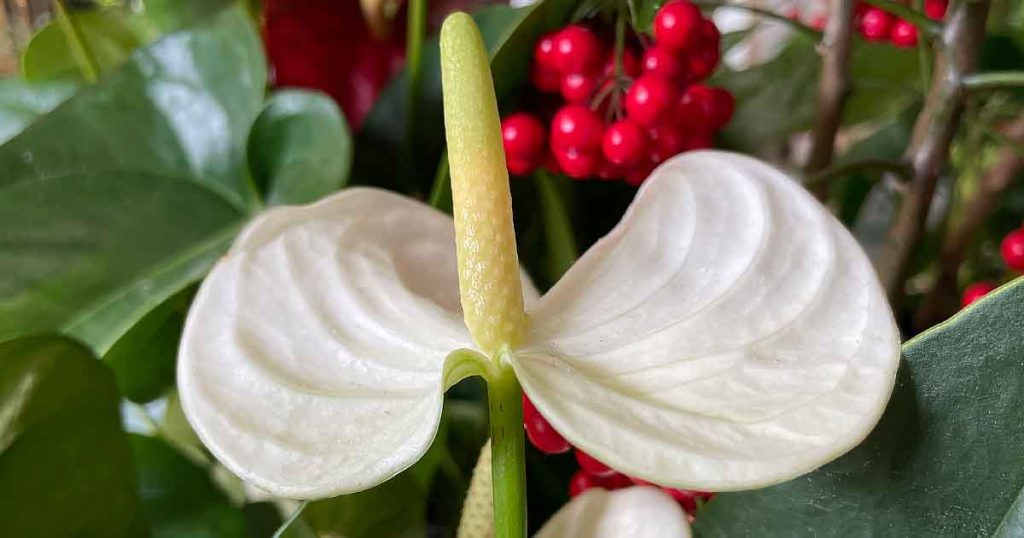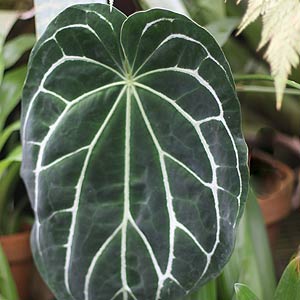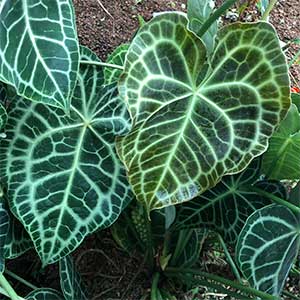
You can grow Anthuriums outdoors in USDA Zones 10 and above, however they are more widely grow as indoor or houseplants.
They are easy care as an indoor plant, because they naturally grow in shade, so place them in a position where they get good filtered light and you are well on the way to success.
Outdoors they need a sub tropical to tropical climate to flower and grow well. Wonderful flowers, some red some white, however some species also have great foliage.
Where are they from
Anthuriums are a plant native to South America and with 100s of species, some are terrestrial and others are epiphytic.

The two main species that are used in many of the colorful modern cultivars are A. andraeanum and A. scherzerianum. They are hardy and as the plants get older they get bigger, both in terms of foliage and the flower bract.
How to Grow Anthurium
General Care
- Anthuriums are really tropical plant, so you need to keep them warm, temperatures below 50f can cause flower drop.
- They also grow in filtered light, so keep them out of direct sun.
- You will notice that Anthuriums have rather thick almost tuberous roots, they require good drainage and do not like to be over watered. However they do not like to dry out either.
- They are also a plant that resents being moved and repotted, especially when they are dormant, so best repot in spring as they commence new growth.
- Do not worry about those arial roots, Anthuriums produce these and its natural.
- If you need to repot Anthuriums use an open potting mix, similar to a fine orchid mix. Normal potting mixes have lots of water retentive materials mixed in and Anthuriums do not like this.
Anthuriums getting to big, well you can cut them off near the base of the plant, again in spring. They will re shoot.
Anthurium grande (pictured right) has heavily veined foliage and makes a wonderful indoor specimen, we believe the correct botanical name for this one is Anthurium conspicuum S orido, syn. Anthurium grande Sorido.
Problems

Like all plants Anthuriums are subject to a few problems, common ones include :
Anthurium not flowering.
Often a problem with Anthuriums grown indoors. Anthuriums require bright diffused light and clean water.
SO – bright light for most of the day but not direct sun and water through summer every day to second day, the rest of the year 2 – 3 times a week
Brown spots on Anthurium foliage.
Often fungal disease caused by overly wet soil and sometimes by misting. The key is excellent drainage, so a free draining soil mix.
Anthurium leaves turn yellow.
The technical term is Chloratic foliage and it can be caused by a number of factors including:
- Cold temperatures – Most common cause
- Insects
- Build up of salts in the soil mix
- Exhausted soil mix
- Poor light
Anthurium Varieties
Over 800 Anthurium species have been identified, some of the more popular species include
- Anthurium andraenum – With the wonderful red flowers, also known as the flamingo lily.
- Anthurium scherzerianum – Another with brilliant red flowers.
- Anthurium hookeri – Also called the ‘Birds nest Anthurium’, green foliage.
- Anthurium crystallinum – Large heart shaped leaves, deep olive green heavily veined with a paler green, most attractive.
- Anthurium bakeri – Commonly called the ‘Birds Nest Anthurium’ rather narrow leaves.
- Anthurium gracile – Also known as the ‘Red Pearls Anthurium’
- Anthurium plownmaii – Also known as ‘Ruffles and ‘Fruffles’ and it grows in drier conditions than most. Large leathery undulating foliage
However it is the colorful hybrids that are the most popular of all.

